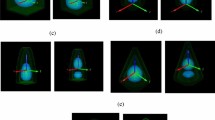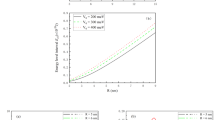Abstract
The Schrödinger equation, which describes the behaviour of an electron with a single dopant inside the system, has been constructed. It is composed of three InAs cubic quantum dots (CQDs) immersed in GaAs material under the influence of an electric field applied along the x-growth direction. The equation has been solved by the finite element method within effective mass approximation. Our investigation shows that in the absence of the electric field, the binding energy (BE) reaches its maximum value when the impurity is at the centre of the system, with two smaller peaks at the other quantum dots (QDs) and a minimum at the centre of the barriers. The BE changes considerably with the electric field, especially for large dots and barriers. Both the BE and the photoionization cross-section (PCS) can be tuned by adjusting the system's dimensions and the electric field. An increase in the dot width, barrier width along the x-axis, or the electric field results in a redshift of photoionization when the impurity is at the centre of the system. The amplitude of the PCS also changes significantly, becoming more pronounced as the dot width or electric field increases and exhibiting non-monotonic behaviour in the case of the barrier width.









Similar content being viewed by others
Data Availability Statement
The manuscript has associated data in a data repository. All the files with tables, figures, and codes are available. The corresponding author will provide all the files in case that they are requested.
References
A. Fakkahi, M. Kirak, M. Jaouane, A. Sali, A. Ed-Dahmouny, K. El-Bakkari, R. Arraoui, The nonlinear optical rectification and second harmonic generation of a single electron confined in a multilayer spherical quantum dot. Opt. Quantum Electron. (2023). https://doi.org/10.1007/s11082-023-04730-y
I. Mal, J. Jayarubi, S. Das, A.S. Sharma, A.J. Peter, D.P. Samajdar, Hydrostatic pressure dependent optoelectronic properties of InGaAsN/GaAs spherical quantum dots for laser diode applications. Phys. Status Solidi (2019). https://doi.org/10.1002/pssb.201800395
A. Zounoubi, I. Zorkani, K. El Messaoudi, A. Jorio, Magnetic field effect on the polarizability of shallow donor in cylindrical quantum dot. Phys. Lett. A 312, 220–227 (2003). https://doi.org/10.1016/S0375-9601(03)00640-6
A. Sali, A. Rezzouk, N. Es-Sbai, M.O. Jamil, The simultaneous effects of the wetting layer, intense laser and the conduction band non-parabolicity on the donor binding energy in a InAs/GaAs conical quantum dot using the numerical FEM. Indian J. Pure Appl. Phys. 57, 483–491 (2019)
Y. Chrafih, K. Rahmani, M. Khenfouch, I. Zorkani, GaAlAs/GaAs cubical inhomogeneous quantum dot (core/shell) under external excitations: the photoionization cross-section of donor impurity with the polaronic effect. J. Nanophotonics 14, 1 (2020). https://doi.org/10.1117/1.JNP.14.016001
C.E. Soliverez, An effective Hamiltonian and time-independent perturbation theory. J. Phys. C Solid State Phys. 2, 301 (1969). https://doi.org/10.1088/0022-3719/2/12/301
C.P. Hilton, W.E. Hagston, J.E. Nicholls, Variational methods for calculating exciton binding energies in quantum well structures. J. Phys. A. Math. Gen. 25, 2395–2401 (1992). https://doi.org/10.1088/0305-4470/25/8/046
J.-L. Liu, J.-H. Chen, O. Voskoboynikov, A model for semiconductor quantum dot molecule based on the current spin density functional theory. Comput. Phys. Commun. 175, 575–582 (2006). https://doi.org/10.1016/j.cpc.2006.06.009
P.-O. Löwdin, I. Mayer, Some studies of the general Hartree-Fock method, in Advances in quantum chemistry. (Academic Press, 1992), pp.79–114
F.S. Levin, J. Shertzer, Finite-element solution of the Schrödinger equation for the helium ground state. Phys. Rev. A 32, 3285–3290 (1985). https://doi.org/10.1103/PhysRevA.32.3285
M. Jaouane, A. Ed-Dahmouny, A. Fakkahi, R. Arraoui, K. El-Bakkari, H. Azmi, A. Sali, F. Ungan, Investigation of nonlinear optical rectification within multilayer wurtzite InGaN/GaN cylindrical quantum dots under the impact of temperature and pressure. Opt. Mater. 147, 114711 (2024). https://doi.org/10.1016/j.optmat.2023.114711
C. Heyn, C.A. Duque, Donor impurity related optical and electronic properties of cylindrical GaAs-AlGaAs quantum dots under tilted electric and magnetic fields. Sci. Rep. 10, 9155 (2020). https://doi.org/10.1038/s41598-020-65862-9
A. Sali, M. Fliyou, H. Satori, H. Loumrhari, Photoionization of impurities in quantum-well wires. Phys. Status Solidi 211, 661–670 (1999). https://doi.org/10.1002/(SICI)1521-3951(199902)211:2%3c661::AID-PSSB661%3e3.3.CO;2-H
A. Sali, M. Fliyou, H. Satori, H. Loumrhari, The effect of a strong magnetic field on the binding energy and the photoionization process in quantum-well wires. J. Phys. Chem. Solids 64, 31–41 (2003). https://doi.org/10.1016/S0022-3697(02)00205-6
A. Sali, H. Satori, M. Fliyou, H. Loumrhari, The photoionization cross-section of impurities in quantum dots. Phys. Status Solidi 232, 209–219 (2002). https://doi.org/10.1002/1521-3951(200208)232:2%3c209::AID-PSSB209%3e3.0.CO;2-O
M. Jaouane, A. Sali, A. Fakkahi, R. Arraoui, F. Ungan, The effects of temperature and pressure on the optical properties of a donor impurity in (In, Ga)N/GaN multilayer cylindrical quantum dots. Micro Nanostruct. 163, 107146 (2022). https://doi.org/10.1016/j.spmi.2021.107146
A. Fakkahi, A. Sali, M. Jaouane, R. Arraoui, A. Ed-Dahmouny, Study of photoionization cross section and binding energy of shallow donor impurity in multilayered spherical quantum dot. Phys. E Low Dimens. Syst. Nanostruct. 143, 115351 (2022). https://doi.org/10.1016/j.physe.2022.115351
V. Holovatsky, M. Chubrey, O. Voitsekhivska, Effect of electric field on photoionisation cross-section of impurity in multilayered quantum dot. Superlattices Microstruct. 145, 106642 (2020). https://doi.org/10.1016/j.spmi.2020.106642
V.V. Mitin, D.I. Sementsov, N.Z. Vagidov, Quantum Mechanics for Nanostructures (Cambridge University Press, 2010)
G. Safarpour, M. Barati, A. Zamani, E. Niknam, Binding energy and optical properties of an off-center hydrogenic donor impurity in a spherical quantum dot placed at the center of a cylindrical nano-wire. J. Lumin. 145, 990–996 (2014). https://doi.org/10.1016/j.jlumin.2013.09.002
M.G. Barseghyan, H.M. Baghramyan, D. Laroze, J. Bragard, A.A. Kirakosyan, Impurity-related intraband absorption in coupled quantum dot-ring structure under lateral electric field. Phys. E Low Dimens. Syst. Nanostruct. 74, 421–425 (2015). https://doi.org/10.1016/j.physe.2015.07.032
R. Arraoui, A. Sali, A. Ed-Dahmouny, K. El-Bakkari, M. Jaouane, A. Fakkahi, The spatial electric field effect on the impurity binding energy and self-polarization in a double quantum dot. Eur. Phys. J. Plus. 137, 979 (2022). https://doi.org/10.1140/epjp/s13360-022-03193-6
M. Jaouane, A. Fakkahi, A. Ed-Dahmouny, K. El-Bakkari, A.T. Tuzemen, R. Arraoui, A. Sali, F. Ungan, Modeling and simulation of the influence of quantum dots density on solar cell properties. Eur. Phys. J. Plus 138, 148 (2023). https://doi.org/10.1140/epjp/s13360-023-03736-5
R. Ram-Mohan, Finite Element and Boundary Element Applications in Quantum Mechanics (Oxford University Press, 2002)
A. Sali, H. Satori, The combined effect of pressure and temperature on the impurity binding energy in a cubic quantum dot using the FEM simulation. Superlattices Microstruct. 69, 38–52 (2014). https://doi.org/10.1016/j.spmi.2014.01.011
A. Bera, M. Ghosh, Simultaneous influence of hydrostatic pressure and temperature on binding energy of impurity doped quantum dots in presence of noise. J. Alloys Compd. 695, 3054–3060 (2017). https://doi.org/10.1016/j.jallcom.2016.11.345
A. Ghosh, A. Bera, M. Ghosh, Influence of binding energy on dipole moment, polarizability and self-polarization effect of impurity doped quantum dots: role of noise. Chem. Phys. Lett. 678, 119–122 (2017). https://doi.org/10.1016/j.cplett.2017.04.042
D. González-Morales, A. Valencia, A. Díaz-Nuñez, Magnetic susceptibility of doped quantum dots: interplay between binding energy and noise. Biointerface Res. Appl. Chem. 10, 5376–5381 (2020). https://doi.org/10.33263/BRIAC103.376381
S. Yılmaz, H. Şafak, R. Şahingoz, M. Erol, Photoionization cross section and refractive-index change of hydrogenic impurities in a CdS-SiO2 spherical quantum dot. Open Phys. (2010). https://doi.org/10.2478/s11534-009-0115-8
A. Imran, J. Jiang, D. Eric, M.N. Zahid, M. Yousaf, Z.H. Shah, Optical properties of InAs/GaAs quantum dot superlattice structures. Res. Phys. 9, 297–302 (2018). https://doi.org/10.1016/j.rinp.2018.02.016
L.-Z. Liu, J.-J. Liu, Hydrogenic-donor impurity states in coupled quantum disks in the presence of a magnetic field. J. Appl. Phys. (2007). https://doi.org/10.1063/1.2764232
M. Jaouane, A. Sali, A. Ezzarfi, A. Fakkahi, R. Arraoui, Study of hydrostatic pressure, electric and magnetic fields effects on the donor binding energy in multilayer cylindrical quantum dots. Phys. E Low Dimens. Syst. Nanostruct. 127, 114543 (2021). https://doi.org/10.1016/j.physe.2020.114543
E. Sadeghi, E. Naghdi, Effect of electric and magnetic fields on impurity binding energy in zinc-blend symmetric InGaN/GaN multiple quantum dots. Nano Converg. 1, 25 (2014). https://doi.org/10.1186/s40580-014-0025-3
A. Ed-Dahmouny, A. Sali, N. Es-Sbai, R. Arraoui, M. Jaouane, A. Fakkahi, K. El-Bakkari, C.A. Duque, Combined effects of hydrostatic pressure and electric field on the donor binding energy, polarizability, and photoionization cross-section in double GaAs/GaAlAs quantum dots. Eur. Phys. J. B. 95, 136 (2022). https://doi.org/10.1140/epjb/s10051-022-00400-2
H. Azmi, N. Amri, K. El-Bakkari, M. Jaouane, A. Fakkahi, A. Sali, R. Arraoui, A. Ed-Dahmouny, Hydrostatic pressure, electric field, non-parabolicity and polaronic mass effects on the donor binding energy in a semimagnetic double quantum well. Eur. Phys. J. Plus. 138, 952 (2023). https://doi.org/10.1140/epjp/s13360-023-04603-z
L. Belamkadem, O. Mommadi, R. Boussetta, S. Chouef, M. Chnafi, A. El Moussaouy, J.A. Vinasco, D. Laroze, C.A. Duque, C. Kenfack-Sadem, R.M. Keumo Tsiaze, F.C. Fobasso Mbognou, A. Kerkour El-Miad, The intensity and direction of the electric field effects on off-center shallow-donor impurity binding energy in wedge-shaped cylindrical quantum dots. Thin Solid Films 757, 139396 (2022). https://doi.org/10.1016/j.tsf.2022.139396
L. Shi, Z.W. Yan, M.W. Meng, Binding energy and photoionization cross section of hydrogenic impurities in elliptic cylindrical core/shell quantum dots under a non-axial electric field. Superlattices Microstruct. 150, 106818 (2021). https://doi.org/10.1016/j.spmi.2021.106818
R. Arraoui, A. Sali, A. Ed-Dahmouny, M. Jaouane, A. Fakkahi, Polaronic mass and non-parabolicity effects on the photoionization cross section of an impurity in a double quantum dot. Superlattices Microstruct. 159, 200 (2021). https://doi.org/10.1016/j.spmi.2021.107049
M. Jaouane, A. Sali, A. Fakkahi, R. Arraoui, A. Ed-Dahmouny, F. Ungan, Photoionization cross section of donor single dopant in multilayer quantum dots under pressure and temperature effects. Phys. E Low Dimens. Syst. Nanostruct. 144, 115450 (2022). https://doi.org/10.1016/j.physe.2022.115450
L.M. Burileanu, Photoionization cross-section of donor impurity in spherical quantum dots under electric and intense laser fields. J. Lumin. 145, 684–689 (2014). https://doi.org/10.1016/j.jlumin.2013.08.043
M. Jaouane, K. El-Bakkari, E.B. Al, A. Sali, F. Ungan, Linear and nonlinear optical properties of CdSe/ZnTe core/shell nanostructures with screened modified Kratzer potential. Eur. Phys. J. Plus. 138, 319 (2023). https://doi.org/10.1140/epjp/s13360-023-03934-1
M. Jaouane, A. Sali, E. Kasapoglu, F. Ungan, Tuning of nonlinear optical characteristics of a cylindrical quantum dot by external fields and structure parameters. Philos. Mag. 103, 693–711 (2023). https://doi.org/10.1080/14786435.2023.2171499
Author information
Authors and Affiliations
Contributions
The contributions of the authors are as follows: MJ worked on numerical computations, programming codes, and outcomes analysis. RA participated in formal analysis and developed the theory. AS proposed the problem, coordinated with coauthors, and revised the manuscript. AE-D, AF, KE-B, and HA focused on the scientific analysis and text production.
Corresponding author
Ethics declarations
Conflict of interest
The authors declare that they have no known competing financial interests or personal relationships that could have appeared to influence the work reported in this paper.
Rights and permissions
Springer Nature or its licensor (e.g. a society or other partner) holds exclusive rights to this article under a publishing agreement with the author(s) or other rightsholder(s); author self-archiving of the accepted manuscript version of this article is solely governed by the terms of such publishing agreement and applicable law.
About this article
Cite this article
Jaouane, M., Arraoui, R., Ed-Dahmouny, A. et al. Finite element method simulation of electronic and optical properties in multi-InAs/GaAs quantum dots. Eur. Phys. J. Plus 139, 222 (2024). https://doi.org/10.1140/epjp/s13360-024-05029-x
Received:
Accepted:
Published:
DOI: https://doi.org/10.1140/epjp/s13360-024-05029-x




